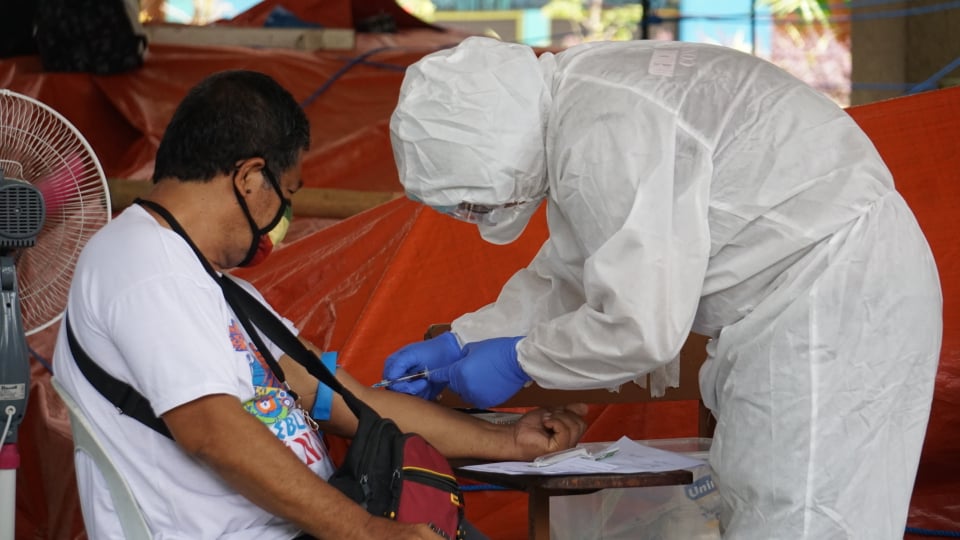
Rapid mass testing being conducted in Barangay Tisa, Cebu City on Thursday, May 7, 2020. CDN Digital photo | CDN file photo (Gerard Vincent Francisco)
CEBU CITY, Philippines — At least 200 persons, who participated in the massive rapid testing in the cities of Cebu, Mandaue, and Lapu-Lapu, will undergo the coronavirus disease test using real-time polymerase chain reaction (rt-PCR).
These individuals consist of 63 from Cebu City, 98 from Mandaue City, and 39 from Lapu-Lapu City.
The rapid testing used in the tri-city determines the presence of antibodies Immunoglobulin M (IgM) and Immunoglobulin G (IgG), which indicate probable infection.
Read more: Three barangays in Lapu exceed target for mass testing
As of May 13, the mass testing in the three cities has already gathered 17,267 blood samples of which Mandaue City has the highest turnout of 7,415.Lapu-Lapu City also yielded 5,351 while Cebu City which has the highest number of COVID-19 cases has the lowest number of participants at 4,501.
Of the 17,267 samples collected since the testing began last May 6, a total of 9,888 have already been processed which yielded 214 positives for IgG, 125 positives for IgM, and 75 positives for both IgG and IgM.
Read more: Gealon: Mass testing is giving City Hall a clearer picture on extent of the infection
Dr. Mary Jean Loreche, Department of Health in Central Visayas (DOH-7) chief pathologist, earlier said that only those, who tested positive for IgM and both IgG and IgM, would have to undergo rt-PCR test to determine if they have COVID-19.
Loreche, in a virtual presser this Thursday, May 14, said they had already advised for the swab collection of the 200 individuals and that their swab samples would be run in designated laboratories for rt-PCR testing in Cebu.
Once the PCR test results would be out, Loreche said that would be the time that they could recommend for proper measures to be taken in a specific area based on the results.
“Once the tests are in, we want to know which households, which barangays, which sitios have the cases so that we will be able to test them, the entire household if we need to do it, and we will determine if it is PCR or rapid testing also until such time that we will be able to be confident that these places can really be said nga medyo okay gyud sila,” Loreche explained.
The doctor clarified that it would be the data from the rt-PCR testing that they would be looking into in recommending measures for each area and not the ones from the rapid tests which were antibody-based.
“The antibody test is given to them so that we will know who will need to undergo the PCR. Why not everybody just do the PCR? Because the PCR is costly, its impractical and the testing facility is not capable of handling hundreds of thousands of tests,” Loreche said.
While there are just two days left based on the original timeline before the testing period ends, the 17, 267 samples from the three cities only represent about 43.55 percent of the target samples.
Read more: Volunteer medtech explains why one should get tested
Loreche said they still consider extending the testing period and go back to communities with low participation in order to extract more samples.
“Dili namo i-encourage nga kung kinsa lang to ang barangay nga willing makuhaan pero na-achieve na ilang quota, sila atong kuhaan. That will be unfair kay katong wala nato nakuhaan basin diay naa didto nagtago ang mga atong mga kinahanglanon nga atong i-testing for PCR,” Loreche said.
(We don’t encourage the idea that only those barangays, who agreed to be tested, but these barangays had hit their quota and that is where we still get the samples. That will be unfair to those who have not yet taken the tests in other barangays. Perhaps, it is there where the needed results to be tested by the PCR are there.)
If they will not meet the 100 percent target in the mass testing, Loreche said they aimed to at least meet 70 percent in order for their data interpretation to be relevant.
Apart from conducting the massive testing as a measure for the reopening of the economy, Loreche said also part of the Project Balik-Buhay would be educating the community with the infection control measures.
“It’s about us going to the grassroots level and teaching the people from the grassroots level on what they can do in order for them to protect themselves,” Loreche said.
“A negative result does not mean and guarantee that you are negative for life. There is such a thing as, you know, you are negative now but kung pabaya ka sa imong kaugalingon, dili ka mag-amping sa imong panglawas, dili ka masinop sa imong gipangbuhat sa sulod sa balay o sa imong opisina (if you don’t take care of yourself, you don’t take care of your health, and you don’t clean your house or your office) then you may also contract the disease,” she added./dbs

